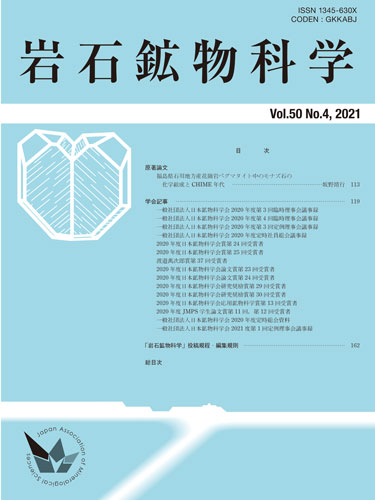52 巻, 1 号
選択された号の論文の13件中1~13を表示しています
- |<
- <
- 1
- >
- >|
鉱物の分析及び実験・解析のコツと勘どころ
-
2023 年 52 巻 1 号 論文ID: 230725
発行日: 2023年
公開日: 2023/12/06
[早期公開] 公開日: 2023/11/21PDF形式でダウンロード (4176K)
日本新産鉱物情報
-
2023 年 52 巻 1 号 論文ID: 231004
発行日: 2023年
公開日: 2023/10/31
[早期公開] 公開日: 2023/10/20PDF形式でダウンロード (1541K)
最近の研究から
-
2023 年 52 巻 1 号 論文ID: 230724
発行日: 2023年
公開日: 2023/09/26
[早期公開] 公開日: 2023/09/07PDF形式でダウンロード (2310K)
解説・資料
-
2023 年 52 巻 1 号 論文ID: 230208
発行日: 2023年
公開日: 2023/09/08
[早期公開] 公開日: 2023/08/09PDF形式でダウンロード (561K)
短報
-
2023 年 52 巻 1 号 論文ID: 230516
発行日: 2023年
公開日: 2023/08/30
[早期公開] 公開日: 2023/08/08PDF形式でダウンロード (976K)
解説・資料
-
2023 年 52 巻 1 号 論文ID: 221029
発行日: 2023年
公開日: 2023/08/03
[早期公開] 公開日: 2023/07/14PDF形式でダウンロード (11156K)
2021年度受賞記念研究紹介
日本鉱物科学会賞第26回受賞者
-
2023 年 52 巻 1 号 論文ID: 230203
発行日: 2023年
公開日: 2023/07/28
[早期公開] 公開日: 2023/06/28PDF形式でダウンロード (7348K)
解説・資料
-
2023 年 52 巻 1 号 論文ID: 230302
発行日: 2023年
公開日: 2023/06/29
[早期公開] 公開日: 2023/05/19PDF形式でダウンロード (2481K)
2021年度受賞記念研究紹介
日本鉱物科学会研究奨励賞第32回受賞者
-
2023 年 52 巻 1 号 論文ID: 230204
発行日: 2023年
公開日: 2023/06/17
[早期公開] 公開日: 2023/05/31PDF形式でダウンロード (2605K)
2021年度受賞記念研究紹介
日本鉱物科学会応用鉱物科学賞第14回受賞者
-
2023 年 52 巻 1 号 論文ID: 230110b
発行日: 2023年
公開日: 2023/06/16
[早期公開] 公開日: 2023/05/26PDF形式でダウンロード (3559K)
博物館紹介
-
2023 年 52 巻 1 号 論文ID: 230127
発行日: 2023年
公開日: 2023/05/13
[早期公開] 公開日: 2023/04/08PDF形式でダウンロード (3762K)
2021年度受賞記念研究紹介
日本鉱物科学会研究奨励賞第31回受賞者
-
2023 年 52 巻 1 号 論文ID: 230110a
発行日: 2023年
公開日: 2023/05/09
[早期公開] 公開日: 2023/04/13PDF形式でダウンロード (6189K)
総説
-
2023 年 52 巻 1 号 論文ID: 221005
発行日: 2023年
公開日: 2023/01/31
PDF形式でダウンロード (1060K)
- |<
- <
- 1
- >
- >|
